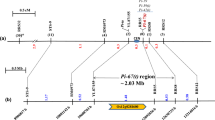Abstract
Samba mahsuri (BPT 5204) is a cultivar of the medium slender grain indica variety of Oryza sativa grown across India for its high yield and quality. However, this cultivar is susceptible to several diseases and pests including rice blast. The analysis of near isogenic lines indicated the presence of a resistance gene, Pi-1(t) in the donor cultivar C101LAC which is highly resistant to the rice blast fungus Magnaporthe grisea (M. grisea). C101LAC was crossed with susceptible indica rice cultivar (BPT 5204) to generate the mapping population. A mendelian segregation ratio of 3:1 for resistant to susceptible F2 plants using bulk segregation analysis confirmed the presence of a major gene pi-1(t) by simple sequence repeats marker RM224 to the highly virulent blast isolate DRR 001.

Similar content being viewed by others
References
Alvarez A, Fuentes JL, Puldon V et al (2007) Genetic diversity analysis of Cuban traditional rice (Oryza sativa L.) varieties based on microsatellite markers. Genet Mol Biol 30:1109–1117
Babujee L, Gnanamanickam SS (1999) Molecular tools for characterization of riceblast pathogen (Magnaporthe grisea) population and molecular marker-assisted breeding for disease resistance. Curr Sci 78:1–12
Barr ME (1977) Magnaporthe, telimenella and hyponectria (Physosporellaceae). Mycologia 69:952–956. doi:10.2307/3758778
Bustamam M, Reflinur, Agisimanto D, Lubis E, Suwarno (2005) Application of molecular marker for the assessment of blast resistance genes, Pi-1 and Pi-2, incorporated into indonesian rice cultivars. J Biotechnol Pertaninan 10(2):51–54
Dean R, Talbort N, Ebbole D, Farman M, Mitchell T, Orbach M, Thon MR, Kulkarni RD, Xu JR, Pan H (2005) Analysis of the genome sequence of the plant pathogenic fungi Magnaporthe grisea, the causal agent of rice blast disease. Nature 434:980–9862. doi:10.1038/nature03449
Flor HH (1956) The complementary genetic systems in flax and flax rust. Adv Genet 8:29–54. doi:10.1016/S0065-2660(08)60498-8
Hittalmani S, Parco A, Mew TV, Zeigler RS, Huang N (2000) Fine mapping and DNA marker-assisted pyramiding of the three major genes for blast resistance in rice. Theor Appl Genet 100:1121–1128. doi:10.1007/s001220051395
Kiyosawa S (1974) Inheritance of blast resistance of a U.S. rice variety, Dawn. Jpn J Breed 24:117–124
Koizumi S (2001) Rice blast control with multilines in Japan. In: Mew TW, Borromeo E, Hardy B (eds) In exploiting biodiversity for sustainable pest management. IRRL, Los Banos, pp 143–157
Koizumi S, Ashizawa T, Zenbayashi KS (2004) Durable control of rice blast disease with multilines. In: Kawasaki S (ed) Rice blast: interaction with and control. Kluwer, Dordrecht, pp 191–199
Kumar LS (1999) DNA marker in plant improvement: an over-view. Biotechnol Adv 17:143–182. doi:10.1016/S0734-9750(98)00018-4
Mackill DJ, Bonman JB (1992) Inheritance blast resistance in near-isogenic lines of rice. Phytopathol 82:746–749
Mohan M, Nair S, Bhagwat A, Krishna TG, Yanto M, Bhatia CR, Sasaki T (1997) Genomic mapping, molecular markers and marker-assisted selection in crop plants. Mol Breed 3:87–103. doi:10.1023/A:1009651919792
Mundt CC (2002) Use of multiline cultivars and cultivar mixtures for disease management. Annu Rev Phytopathol 40:381–410. doi:10.1146/annurev.phyto.40.011402.113723
Ou SH (1985) Rice diseases, 2nd edn. Commonwealth Mycological Institute, UK, pp 109–200
Prasad MS, Mohan KM, Madhav KS, Arunakanthi B, Balachandran B, Ravindrabababu SM, Muralidharan K (2007) Identifying novel blast resistance genes in popularly grown rice varieties, 2nd Asian congress of mycology and plant pathology held at Osmania University, Hyderabad from 19–22 December, 2007
Rathour R, Singh BM, Plaha P (2006) Virulence Structure of the Magnaporthe grisea rice population from the Northwestern Himalayas. Phytoparasitica 34(3):281–291. doi:10.1007/BF02980957
Rossman AY, Howerd RJ, Valent B (1990) Pyricularia grisea, the correct name for the rice blast disease fungi. Mycologia 82:509–512. doi:10.2307/3760024
Silue DJ, Notteghem L, Tharreau D (1992) Evidence of a gene-for-gene relationship in the Oryza sativa Magnaporthe grisea pathosystem. Phytopathol 82:577–580. doi:10.1094/Phyto-82-577
Swarup K, Parida K, Kumar A, Dalal V, Singh NK, Mohapatra T (2006) Unigene derived microsatellite markers for the cereal genomes. Theor Appl Genet 112:807–808. doi:10.1007/s00122-005-0182-1
Valent B, Crawford MS, Weaver CG et al (1986) Genetic studies of fertility and pathogenicity in Magnaporthe grisea (Pyricularia oryzae). Iowa State J Res 60:569–594
Yu ZH, Mackill DJ, Bonman JM, Tanksley SD (1991) Tagging genes for blast resistance in rice via linkage to RFLP markers. Theor Appl Genet 81:471–476. doi:10.1007/BF00219436
Zeigler RS, Tohme J, Nelson R, Levy M, Correa F (1994) Linking blast population analysis to resistance breeding; a proposed strategy for durable resistance. In: Zeigler RS, Leong S, Teng PS (eds) Rice blast disease. CAB International, Wallingford, pp 267–292
Zheng KL, Qian HR (1991) DNA polymorphism generated by arbitrary primed PCR in rice. Rice genetic Newslett 8:134–136
Zhu YY, Chen HR, Fan JH, Wang YY, Li Y, Chen JB, Fan JX, Yang SS, Hu LP, Leung H, Mew TW, Teng PS, Wang ZH, Mundt CC (2000) Genetic diversity and disease control in rice. Nature 406:718–722. doi:10.1038/35021046
Acknowledgments
The authors are grateful to the Department of Biotechnology (DBT), New Delhi for providing financial assistance.
Author information
Authors and Affiliations
Corresponding author
Rights and permissions
About this article
Cite this article
Prasad, M.S., Kanthi, B.A., Balachandran, S.M. et al. Molecular mapping of rice blast resistance gene Pi-1(t) in the elite indica variety Samba mahsuri. World J Microbiol Biotechnol 25, 1765–1769 (2009). https://doi.org/10.1007/s11274-009-0074-7
Received:
Accepted:
Published:
Issue Date:
DOI: https://doi.org/10.1007/s11274-009-0074-7




